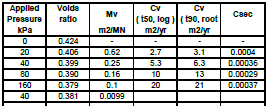Aluminium_Soil
Geotechnical
- Apr 7, 2022
- 4
Hi all,
Just trying to clarify something.
As the title suggests I am attempting to derive a characteristic Mv value for a cohesive soil using the oedometer test.
I have read online, people sometimes average given Mv values for all incremental pressures and take an average.
This seems way too obvious to be inaccurate for design purposes (perhaps I'm wrong).
Anyways I am struggling with interpreting the results.
I have an Mv value for each pressure increment, doubling from overburden up to 5x the expected load for the soil, then unloading back to overburden.
Is it as simple as selecting the Mv value for the known load of the structure?
The problem exists where the Mv value at 50 kPa on the lab test is way higher compared to 100/150 kPa?
(I understand its a function of a larger initial height change in the sample, where PwP dissipates which becomes gradually smaller overtime).
So if using the Mv value for a house designed to bear at 50 kPa, when calculating consolidation settlement this almost always returns excessive settlement and cannot be limited to 25 mm.
My thought is that surely a house designed to bear 50 kPa obviously a lighter load, would settle less than a 100 kPa house but when using the Mv for 100 kPa the house settles less?!?
Maybe I am missing something or would like to understand how you interpret oedometer results.
Any help is greatly appreciated - I'm at a loss after going through 6 books.
Just trying to clarify something.
As the title suggests I am attempting to derive a characteristic Mv value for a cohesive soil using the oedometer test.
I have read online, people sometimes average given Mv values for all incremental pressures and take an average.
This seems way too obvious to be inaccurate for design purposes (perhaps I'm wrong).
Anyways I am struggling with interpreting the results.
I have an Mv value for each pressure increment, doubling from overburden up to 5x the expected load for the soil, then unloading back to overburden.
Is it as simple as selecting the Mv value for the known load of the structure?
The problem exists where the Mv value at 50 kPa on the lab test is way higher compared to 100/150 kPa?
(I understand its a function of a larger initial height change in the sample, where PwP dissipates which becomes gradually smaller overtime).
So if using the Mv value for a house designed to bear at 50 kPa, when calculating consolidation settlement this almost always returns excessive settlement and cannot be limited to 25 mm.
My thought is that surely a house designed to bear 50 kPa obviously a lighter load, would settle less than a 100 kPa house but when using the Mv for 100 kPa the house settles less?!?
Maybe I am missing something or would like to understand how you interpret oedometer results.
Any help is greatly appreciated - I'm at a loss after going through 6 books.

